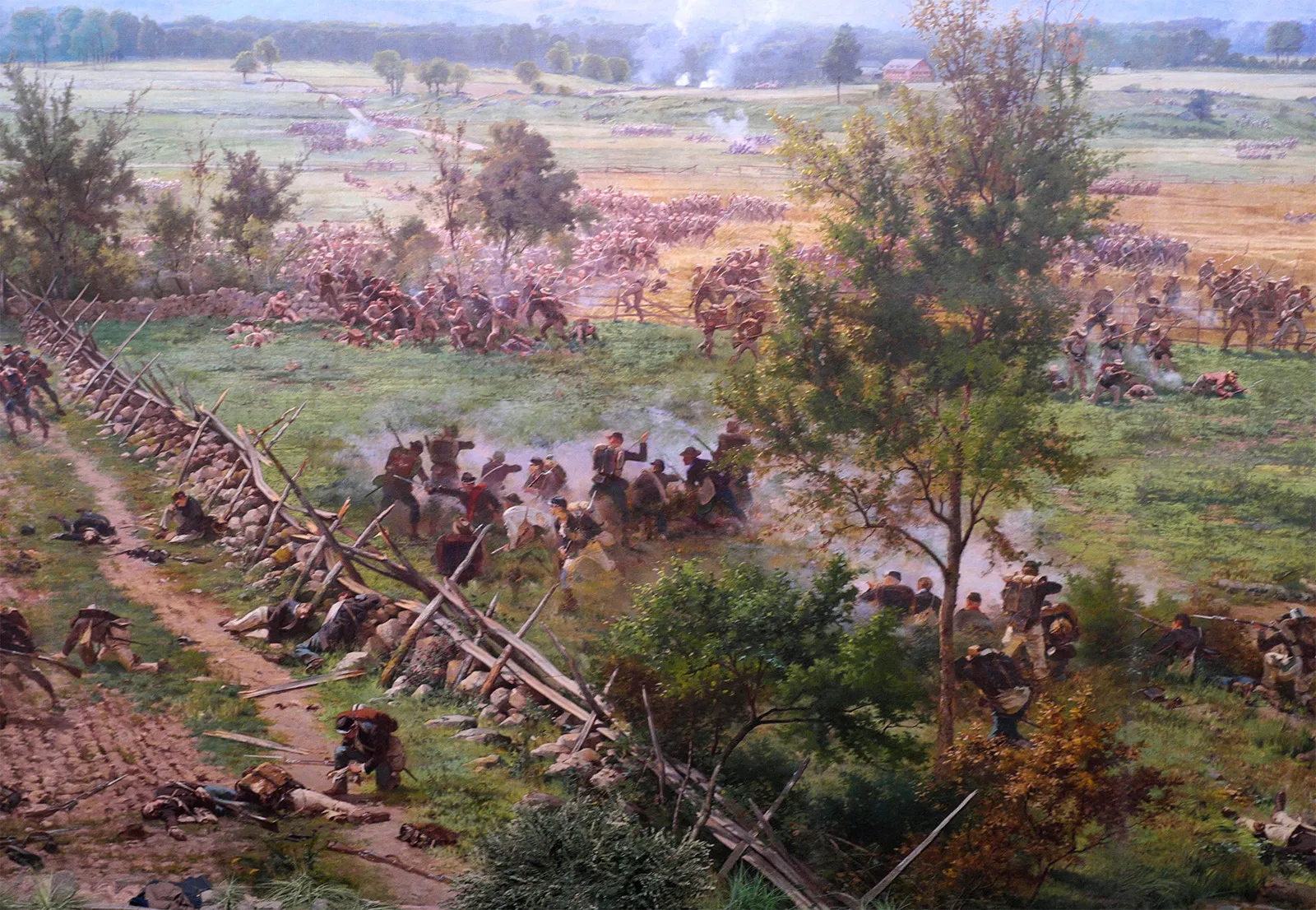by Gordon Thorsby

Gettysburg Cyclorama Pickett's Charge (in same general area of Anderson's Attack)
We talk about Generals John Bell Hood, Jubal Early and John B. Gordon, as among the toughest fighters in the Army of Northern Virginia in the Civil War. They were commanders that led divisions and in higher positions as the war progressed. Rarely is Richard “fighting Dick” Anderson mentioned but his record earns such distinction.
Richard Anderson (October 7, 1821 -- June 26, 1879) was South Carolina born and raised when he attended West Point (Class of 1842), graduating 40 out of 56, a most famous graduating class. He was the grandson of Revolutionary War Colonel Richard Anderson and veteran of battles that included Guilford Courthouse, Cowpens and Camden, twice wounded. Young Richard Anderson’s first Confederate commission was with the 1st South Carolina Infantry and second in command at Ft Sumter at the very fight of the War. When P.G.T. Beauregard, the Commander, went north to take command in Virginia, Anderson took over the Charleston Harbor forces. When the war shifted to the Peninsula in 1862, Dick Anderson served under Longstreet where he earned the nickname he forever held. On July 14, 1862, he was promoted to division command for that unshakable aggressiveness. Anderson continued his fighting ways at Second Manassas and Antietam where he was wounded.

On July 2, at Gettysburg, it was Anderson’s division that came the closest to breaking the Union line on Cemetery Ridge, the same route Lee ordered the following day by most of three divisions in Pickett’s Charge that had lesser results. There was no denying, Anderson (right) fought hard every time he was called on. He commanded Longstreet’s Corps in 1864 when Longstreet was wounded and Anderson performed well. He raced the Corps south to get to Spotsylvania Courthouse and saved Lee’s army from Grant's flanking maneuver. It was while Anderson was pushing his troops to Spotsylvania, his father passed on May 10, yet Anderson didn’t stop for a moment. At Petersburg several months later, Lee gave Anderson his own IV Corps and the defenses of Richmond.
At the breakthrough at Petersburg, Anderson's Corps had to gain separation from the pursuing forces but was something virtually impossible to accomplish. While plugging breaches from almost every direction by marauding Union cavalry, Anderson’s depleted Corps was almost encircled and most of it was captured at Sailor’s Creek April 6th. This was where Gen. Robt E. Lee from the crest of a ridge, said the phrase, “My God, has this army dissolved.” The next day, "Fighting Dick" Anderson was relieved of command and of duty. His relief of command is the actual point of this article.
There are nagging questions that seem unsatisfactorily answered.
The evening before, Lee dictated orders to Col. Walter Taylor, his adjutant, that ordered Anderson, his fighting general, somebody he had relied on when other men went down “relieved of command” and “he [Anderson] was to repair to his home or whatever else he might choose and report to the Secretary of War” (John C. Breckinridge.) Lee had not hesitated a moment. It was later documented that according to Taylor, Lee placed blame for both Five Forks and Sailor’s Creek directly on Anderson. The tone seems that through the years since the war somebody had to take the blame for Five Forks and Sailor’s Creek and Anderson “fit the bill perfectly.” Anderson was the commander of the Corps that broke. It is true that Five Forks was a defeat and probably an inevitable one. It was not if, it was when.
The war was over. Was it fair to blame Richard Anderson for the defeat or was this a “reputational lynching?” If not Richard H. Anderson, who is to blame or should there be blame at all?
Life resumed for Dick Anderson as he tried to resume life in the South Carolina. Dick Anderson was about to find new battles. Maybe his newest fight was rebuild his reputation honorable. He went into planting in Statesburg, SC in 1866 and failed at it resulting in near bankruptcy. He worked on the South Carolina Railroad in an unknown and possibly menial capacity for almost ten years and was fired. He served in lesser jobs thereafter and some sources indicated he even worked as a day laborer for low wages. Richard Anderson lost the ultimate fight, that of life at the age of 57 in 1879, and penniless. He is buried at Parish Church in Beaufort, SC and was given a prominent marker like a great general should have (Daughters of the Confederacy. Anderson fought in every major battle of the Army of Northern Virginia.
Somewhere, up there, Richard Anderson has taken on some cause he has chosen and is fighting it still.

Note: Anderson was supposedly paroled in September 1865, but records do not exist. Maybe he was not done fighting…
Sources:
William Marvel, Lee’s Last Retreat, University of North Carolina Press, 2002.
Find-a-Grave, Richard H. Anderson.
American Battlefield Trust.

